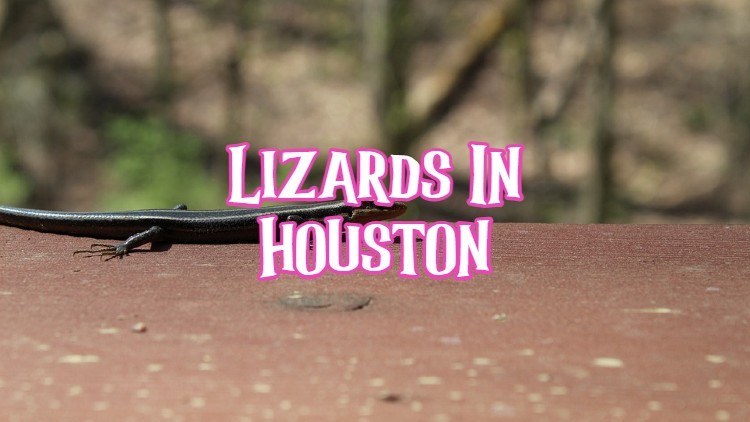Houston is home to a diverse range of reptiles, including various species of lizards. Lizards play an important role in the local ecosystem by helping control insect populations and serving as prey for other animals. While Houston has no venomous lizards, some species can bite if threatened. This article will discuss the 10 most common types of lizards found in and around Houston, providing key identification features, habitat information, and fun facts.
1. Green Anole
The green anole (Anolis carolinensis) is one of the most ubiquitous lizards in Houston It has a green body that can range from bright green to brown, a slender build, a pointed snout, and adhesive toe pads for climbing Males have a pink or reddish throat fan called a dewlap. Green anoles are arboreal, often found on trees, fences, and the sides of houses. They eat insects and can change color based on temperature or stress.
Fun fact The green anole is able to run across water for short distances by using its hind and forelegs alternately
2. Brown Anole
Similar in appearance to the green anole, the brown anole (Anolis sagrei) has invaded southeast Texas from the Caribbean. It has a brownish body with light stripes and splotches, a triangular head, and an orange dewlap in males. Unlike the green anole, the brown anole prefers ground habitats. It is displacing green anoles in urban areas by being more aggressive.
3. Mediterranean House Gecko
The Mediterranean house gecko (Hemidactylus turcicus) is a nocturnal species with tan skin, dark spots, and large eyes with vertical pupils. They have adhesive toe pads that allow them to climb walls. Introduced from the Mediterranean, these geckos are common in suburban areas of Houston, often near exterior lighting where insects gather.
Fun fact: The Mediterranean house gecko makes a distinct vocalization that sounds like “chuck-chuck-chuck.”
4. Texas Spiny Lizard
Also called the Texas fence lizard, the Texas spiny lizard (Sceloporus olivaceus) is common in suburban areas. It has a spiny appearance with pointy scales down its back. Coloration is gray, brown or olive with light undersides. Males have blue patches on their bellies. As the name suggests, these lizards like climbing on fences, tree trunks and telephone poles.
5. Little Brown Skink
The aptly named little brown skink (Scincella lateralis) is a small brown ground lizard with dark stripes along its sides. It has smooth, shiny scales and grows up to 5 inches long. This skink spends most of its time buried in leaf litter, seldom climbing. It prefers wooded habitats and suburban gardens throughout the Gulf Coast region.
6. Broad-headed Skink
Growing up to 13 inches long, the broad-headed skink (Plestiodon laticeps) is one of Houston’s largest lizards. It has a wide triangular head and jaws, a brown to black body with stripes, and short legs. Males develop reddish heads and necks. Juveniles have striking blue tails. These skinks live on the ground and in trees in wooded areas.
Fun fact: When threatened, broad-headed skinks can detach their tails which then wriggle on the ground to distract predators.
7. Six-lined Racerunner
The six-lined racerunner (Aspidoscelis sexlineata) is named for the six yellowish stripes running down its back and sides. It has a slender build and can reach speeds up to 18 mph using its long hind legs. Native to the southern Great Plains, this ground lizard has adapted to disturbed habitats in the Houston area.
8. Eastern Fence Lizard
Also called the prairie lizard, the eastern fence lizard (Sceloporus undulatus) has keeled scales giving it a spiny look. Coloration varies geographically, but Houston specimens are typically brown or gray with light lines along the back. As the name implies, these lizards frequent fences and wood piles. When threatened, they can detach their tails.
9. Common Five-lined Skink
The largest skink in Houston, the common five-lined skink (Plestiodon fasciatus) lives on the ground and in trees. It has a cylindrical body shape with short legs and grows over 8 inches long. Identifying features include five distinct light stripes down the back and sides, over a brown or black body. Males may develop reddish heads.
10. Glass Lizard
Though resembling a snake, the glass lizard (Ophisaurus sp.) is actually a legless lizard. Two species found in Houston are the slender glass lizard (O. attenuatus) and the eastern glass lizard (O. ventralis). They have long, snake-like bodies with tan, brown or green coloration and dark lines or spots. Key differences from snakes include movable eyelids and external ear openings.
Fun fact: Glass lizards detach their tails when threatened, which then writhe on the ground to distract predators. The tail eventually grows back.

What is up with all the brown lizards in Houston?
FAQ
Is it safe to touch a brown anole?
Anoles are not lizards for handling. You shouldn’t touch them or bother them at all unless you need to–like cleaning the enclosure.
Why do I have lizards in my yard?
-
Food:Lizards are insectivores, meaning they primarily eat insects. If your yard has a thriving insect population, it will attract lizards.
-
Shelter:Lizards need places to hide and bask in the sun. Rocks, plants, piles of lumber, and even the exterior walls of your home can provide shelter.
-
Water:Lizards need access to water, especially in dry climates. Leaking pipes, stagnant water, or even a leaky sink can attract them.
-
Wandering:Lizards may simply be wandering through your yard in search of food or shelter, and if they find it, they may stay.
-
Beneficial:It’s important to remember that lizards can be beneficial to your yard by consuming insects, which can help control pest populations.
What’s the most common lizard in Texas?
Common lizards in the San Antonio area include the Green Anole, Rosebelly Lizard, Texas Spiny Lizard, Texas Alligator Lizard, Common Spotted Whiptail, and Ground Skink. CAN YOU NAME ONE OF THESE LIZARDS THAT CAN CHANGE THE COLOR OF ITS SKIN TO BROWN? Like many birds and mammals, reptiles are predators.
